A summary of my impressions of Portland, Oregon and planning (reprint)
I forgot to include this "case study" in my overview outline for a paper outlining a linked transportation and land use planning paradigm for DC.
Reprinted from 10/14/2005
People that know me know that I am into, if not obsessed with reading newspapers. I even read newspaper "biographies." A book about the New York Herald-Tribune commented on "big foot journalism" where a well-known columnist jets in somewhere, is taken around by handlers, and then write a column that purports to be the be-all and end-all analysis of the situation ("I was there"), angering the journalists that are there all the time, and have a much more nuanced understanding of "the way things really are." (cf. the book The Ugly American)
Well, I can't claim that I know everything about Portland Oregon after being there for a week, but a good thing about the National Trust conference is that you get a structured introduction to a city. If you go there with a set of lessons and thoughts in mind, you can learn tons in a short time, even if you don't learn the entire picture.
Most of the reason that downtown Portland is still vibrant at the scale of building and block is because most of the historic buildings--their massing and scale, zero setback at the sidewalk, rhythm of the retail storefronts, variety of sizes of the buildings, etc.--have been retained.
Additionally, Downtown Portland remains the Central Business District of the region because (1) urban growth boundaries militate against sprawl; and (2) transit infrastructure investments were expended that further strengthened its centrality.
Rather than allow for the deconcentration of of the region away from the center through sprawl and new construction of of multiple business districts around the region, Downtown Portland remained and retained its importance as the "Central" business district. Yes there is still development in the suburbs, particularly around high-tech office campuses, and yes, there are vacant spaces and buildings downtown, but overall it works pretty well, with an active life on the street, due to the retention for the most part of, compared to DC, smaller office buildings rather than a focus on the new construction of superblock superbuildings.
Two clear negatives. (1) On 5th Avenue south of Jefferson, many relatively new buildings have been constructed of cheaper materials, taking up whole blocks, with deep setbacks from the street-sidewalk. This area exhibits little of the vitality of the streets north. (2) Transit malls are efficient but a sea of bus traffic isn't attractive. I don't know if this would have worked better if at the southern end the blocks hadn't been transformed by superblockization. I didn't ride the buses enough to really get a sense of this area, but it bears some serious consideration.
OTOH, the Pearl District is getting many "tall" new buildings, and is seeing the conversions of older warehouse buildings. (Much of this area used to be industrial, and was served by a freight railyard.) As I said in an earlier posting, these buildings look pretty good. But in the great scheme of things, they aren't that high. I don't think I saw a building over 16 stories in height. That's a lot different from Vancouver, BC. Plus, these buildings are intermingled with historic buildings of varying heights that allow for the development of vibrant and varied retail and housing options.
This travel article from the SF Chronicle What's old is new again in Portland's gem - Lively Pearl District teems with galleries, shops and clubs is a nice discussion of the Pearl District. As a Portland planning official put it in a side conversation, the extant historic buildings provide design cues and references for design of new buildings that feels more authentic.
We've lost much of that in DC. Many of the buildings downtown and along K Street NW are superbuildings taking up most of a block. They are boxy and little distinguishes these buildings architecturally.
____________
Portland Oregon's Downtown Plan (from material distributed for a walking tour)
The Downtown plan, adopted in 1972, was intended to maintain and strengthen downtown's central role in the city by reinforcing its mix of uses--including office, retail, cultural, governmental and residential. The major concepts included:
1. Creating a North-South spine of high density offices served by public transit. The (bus) Transit Malls on SW 5th and 6th Avenues, completed in 1978, provides this spine and supported private office developments.
2. Creation of an East-West retail spine along Morrison Street that would lead the city back to the river. The MAX light rail line and rebuilt streets on Morrison and Yamhill implement that concept. Waterfront Park, which replaced an expressway, provides a riverfront destination.
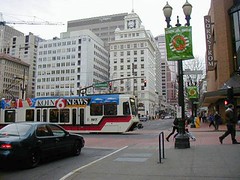 Pioneer Courthouse Square North, MAX Blue Line, Portland, Oregon. (Note the Nordstrom's.) Photo by Adam J. Benjamin.
Pioneer Courthouse Square North, MAX Blue Line, Portland, Oregon. (Note the Nordstrom's.) Photo by Adam J. Benjamin.3. Recognition and support for the subdistricts in downtown. The Skidmore and Yamhill Historic Districts are two premier examples of those subdistricts and zoning regulations were modified to protect them and funds were invested by the public and private sectors for rehabilitation.
4. Emphasis on transit and alternative modes for downtown access and limitations on parking. The plan prohibited new parking unless associated with new development and it prohibited the demolition of historic buildings for parking lots.
5. Design regulations to promote active street level storefronts--with retail space, public lobbies, and other pedestrian features typical of historic commercial buildings.
6. Policies to maintain the historic, fine-grained street grid and blocs. Vacating streets to form larger blocks and skybridges are rare in downtown. This helps to maintain an active street life.
7. Policies and programs to protect and promote fragile uses like housing, retail and hotels through public and private investments and regulation.
____________
The smart founders of Portland created a street grid of 200' by 200' blocks. In DC the typical block is about 270' by 270'. In Portland, in 800', they yielded four blocks, with 16 corners--four extra prime corner locations to sell or rent, compared to three blocks and 12 corners in the same area in Washington, DC.
Because I don't have the right kind of camera features, I didn't take many photos of large buildings in Portland, but the website Portland Ground is an excellent source
______
Portland's Lessons:
1. Urban growth boundaries and state planning requirements are essential to keeping growth compact and centered, utilizing preexisting infrastructure, and maintaining the worth of extant land and buildings, rather than the typical metropolitan area which experiences development further and further out, and where the politics and the economics of the region tend to be disconnected from the issues and needs of the center city.
UGBs are likely the reason for the maintenance and predominance of independently-owned retail in Portland, Oregon. I intend to write about this more in-depth in another blog entry, but the short answer is that it is likely that the Portland region hasn't experienced the quadrupling of retail space over the past 40 years experienced by other regions in the United States. Thank UGBs.
2. People with vision and commitment to more than just making money are essential to keep assets grounded in historic preservation and the other qualities that promote livability. In Portland, two brothers, the McMenamins, have bought many old theaters and school buildings and rehabilitated them into unique entertainment properties, especially with theaters. So in Portland many neighborhoods still have local theaters, although there are some chain theaters downtown. In DC, most every neighborhood theater has long ago been converted into a drugstore or similar non-"public" community-gathering-oriented use.
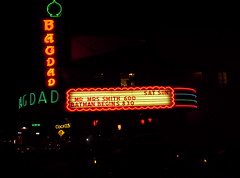 The McMenamin-owned Baghdad Theater is one of the centerpieces of the Hawthorne retail district, which also includes a Powell's branch open late, a Powell's specialty store, "Books for Cooks and Gardeners," the specialty food store Pastaworks, and many independent stores and restaurants.
The McMenamin-owned Baghdad Theater is one of the centerpieces of the Hawthorne retail district, which also includes a Powell's branch open late, a Powell's specialty store, "Books for Cooks and Gardeners," the specialty food store Pastaworks, and many independent stores and restaurants.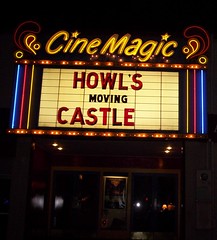 A one screen independent Cinema in Portland Oregon, showing an animated film, about one mile away from the Baghdad Theater.
A one screen independent Cinema in Portland Oregon, showing an animated film, about one mile away from the Baghdad Theater.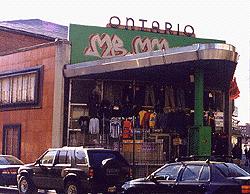 The Ontario Theater in DC's Adams-Morgan neighborhood has been converted into a discount clothing store and a CVS drug store.
The Ontario Theater in DC's Adams-Morgan neighborhood has been converted into a discount clothing store and a CVS drug store.Bill Naito was one of the leading developers in Portland. He renovated key properties, and focused a lot of his own time and attention on issues that were essential to the strengthening and extension of the city's livability and the public spaces. Portland renamed the riverfront parkway in his honor.
In contrast, most DC developers have been ruthless about demolishing historic buildings in Downtown in favor of superbuildings, wrecking pedestrian vitality at the street level. DC's commercial office building market thrives while the retail environment suffers. Seventh Street NW is an exception. People attribute this to the MCI Center, but I disagree, believing it is because this street is the longest stretch remaining of historic buildings, with a size and scale that is oriented to people and walking, rather than the car. This stretch, from about Pennsylvania Avenue to New York Avenue. Fortunately at the street level the new building at Gallery Place follows this pacing, and so do the stores, such as Urban Outfitters, that have located there.
(DC developer Doug Jemal has been committed to historic buildings, and he has done some great work all around the city, particularly on 7th Street NW, but he hasn't had the same kind of public presence or role in the public sphere comparable to that of Bill Naito in Portland. In DC, traditional developers, oriented to big buildings with plenty of parking, have called the shots.)
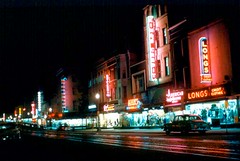 F Street NW, Washington DC, in the 1950s. Photo from www.restonpaths.com
F Street NW, Washington DC, in the 1950s. Photo from www.restonpaths.com Developed by the Oliver Carr Company, International Square on K Street is a typical downtown building, interior-focused, with anti-pedestrian scale at the street level. The building is very large, taking up the entire square. Atrium photo shot from the underground(!) food court, via www.virtualtourist.com
Developed by the Oliver Carr Company, International Square on K Street is a typical downtown building, interior-focused, with anti-pedestrian scale at the street level. The building is very large, taking up the entire square. Atrium photo shot from the underground(!) food court, via www.virtualtourist.com3. Continued focus on development of the core. I don't know if this is a separate entry or merely a subentry under (1) above. But the combination of urban growth boundaries, transit investments, and a focus on extending livability such as the creation and continued development of waterfront parks on both sides of the river not only keeps Portland relevant but dominant in the Portland metropolitan region as the number one place to work, live, and relax. Many Portland neighborhoods, especially those with Streetcar or Light Rail service, are experiencing a resurgence and increased demand for housing.
This isn't to say all is well. Not every street and block in downtown Portland thrives, but there is a lot more going on that is positive rather than negative.
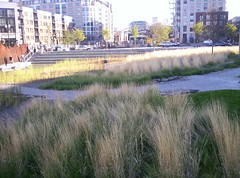 New park in the Pearl District, constructed as part of community amenities requirements associated with new developments.
New park in the Pearl District, constructed as part of community amenities requirements associated with new developments.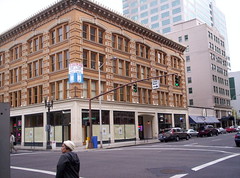 For lease in Yamhill District.
For lease in Yamhill District.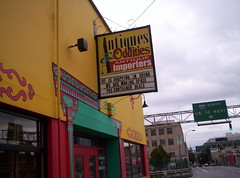 160,000 s.f. abandoned Meier & Frank Warehouse in the background. (Meier & Frank was owned by May Department Stores, owners of The Hecht Company.)
160,000 s.f. abandoned Meier & Frank Warehouse in the background. (Meier & Frank was owned by May Department Stores, owners of The Hecht Company.)4. Jane Jacobs says that one of the four key factors to successful center cities is a large stock of old buildings. She said this not because she is a preservationist, but because buildings that have been paid off cost less to rent, and therefore are natural incubators of innovation. Be it retail, industrial, or service, all can be accommodated in such buildings.
But what makes this work more practically in Portland again comes down to urban growth boundaries that prevent sprawl and also prevent the construction of speculative new buildings that make obsolete otherwise perfectly usable buildings. Because this kind of new construction doesn't happen so much in Portland's suburbs, builidngs in the center city are still valued. Because Portland was an active port and industrial center, there are many buildings, particularly in the industrial-manufacturing quarter on the east side of the river that is experiencing a great deal of renewed interest. Because of the decline in manufacturing, there is still a surfeit of buildings available.
The rents in Portland, for industrially-appropriate space (which includes software development, graphic design, and architecture) run under $20/s.f., and as I mentioned before, in many attractive retail districts, rents range from $12-$20/s.f.
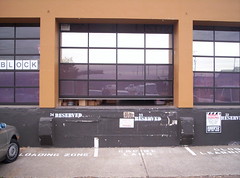 By retaining loading docks, and making them part of leasable spaces, the East Bank Commerce Center can attract tenants who need the convenience of in-space loading and unloading facilities.
By retaining loading docks, and making them part of leasable spaces, the East Bank Commerce Center can attract tenants who need the convenience of in-space loading and unloading facilities.5. Active streets and mixed uses are maintained through most city policies. The Pearl District is a perfect example. Retaining historic buildings, their storefronts, a mix of activities and uses throughout the day and into the evening, and the pedestrian-scaled rhythm of the street makes for a lively city.
6. Transit investment is substantive and continues. Portland understands the importance of keeping the city relevant in the region by making it easier to get around. Transit services are on and part of the streets, but transit doesn't overwhelm the street, and they are designed from the outset to maintain and enhance the economic value of residential and commercial property in the areas that are serviced.
With the streetcar, north and eastbound services run on one street, while service in the other direction runs on another street. The same goes for MAX service in the Center City, trains in one direction run on Morrison Avenue, and on the other direction on Yamhill. Outside of the center city, the system runs on parallel double tracks.
Generally streetcars are intended to provide more stops and service for trips of shorter duration. Light rail is "heavier" and more expensive to build and provides fewer stops and speedier travel, and runs on the ground. Heavier rail is what in DC is the mostly underground subway. An advantage of underground service is that it's fast because it is not impeded by crossings. It's also very expensive to construct. Just to install an inline station on the extant system (New York Avenue station) cost close to $120 million.
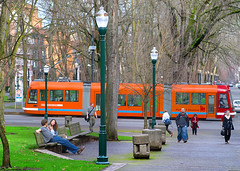 Portland Streetcar near Portland State University. Photo: Portland Ground.
Portland Streetcar near Portland State University. Photo: Portland Ground.Streetcar Planning Goals for Portland:
-- Link neighborhoods with a convenient and attractive transportation alternative.
-- Fit the scale and traffic patterns of existing neighborhoods.
-- Provide quality service to attract new transit ridership.
-- Reduce short inner-city auto trips, parking demand, traffic congestion and air pollution.
-- Encourage development of more housing & businesses in the Central City.
These are sound planning principles for every community!
The Portland Streetcar, which is run by the city, has about 6,000-7,000 riders/daily, while the MAX system averages close to 100,000 daily riders, over a 44 mile system.
The thing we have to remember is that DC transit usage is far higher than most cities, including Portland, Oregon. Most of the high use bus lines in DC proper have greater ridership than the Portland Streetcar, although DC bus ridership is not higher than Portland's light rail, which is more comparable to DC's subway system. But the WMATA subway crushes Portland's system in terms of daily ridership (our system covers more ground and more people work in Downtown DC). DC's system has over 100 miles of track and serves between 500,000 and 800,000 daily riders.
For a lot more discussion and photos of transit in Portland, check out the NYC Subway World page on Portland, as well as this section from Light Rail Now.
Labels: transit, transportation planning, urban design/placemaking, urban revitalization



1 Comments:
Just came across a 2014 piece from Willamette Week, the alternative newsweekly for Portland, with more back story on how light rail came about:
https://www.wweek.com/portland/article-23466-feb-4-1974-portland-kills-the-mount-hood-freeway.html
1/23/2019
Post a Comment
<< Home